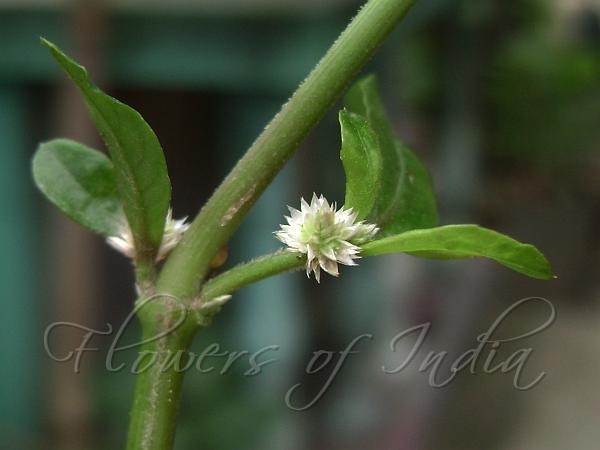|
| Stalkless Joyweed |
|

|

|
|
|
Photo: |
Botanical name: Alternanthera sessilis Family: Amaranthaceae (Amaranth family)
Stalkless Joyweed is a perennial herb, often found in and near ponds,
canals and reservoirs. It prefers places with constant or periodically
high humidity and so may be found in swamps, shallow ditches, and fallow
rice fields. A much branched prostrate herb, branches often purplish,
frequently rooting at the lower nodes; leaves simple, opposite, somewhat
fleshy, lanceolate, oblanceolate or linear-oblong, obtuse or subacute,
sometimes obscurely denticulate, glabrous, shortly petiolate; flowers
small, white, in axillary clusters; fruits compressed obcordate utricles,
seeds suborbicular. In Manipur, tender shoots and leaves are eaten
cooked with rice along with fermented soyabean. Stalkless Joyweed
is found in the Himalayas, at altitudes of 200-2000 m.
Medicinal uses: Stems and leaves useful in eye trouble.
Decoction is taken with little
salt drunk to check vomiting of blood. Shoot with other ingredients used to
restore virility. Poultice used for boils.
Stems and leaves useful in eye trouble.
Decoction is taken with little
salt drunk to check vomiting of blood. Shoot with other ingredients used to
restore virility. Poultice used for boils.
Medicinal uses:
 Stems and leaves useful in eye trouble.
Decoction is taken with little
salt drunk to check vomiting of blood. Shoot with other ingredients used to
restore virility. Poultice used for boils.
Stems and leaves useful in eye trouble.
Decoction is taken with little
salt drunk to check vomiting of blood. Shoot with other ingredients used to
restore virility. Poultice used for boils.| Identification credit: Rakesh Singh | Photographed in Gujarat. |
• Is this flower misidentified? If yes,